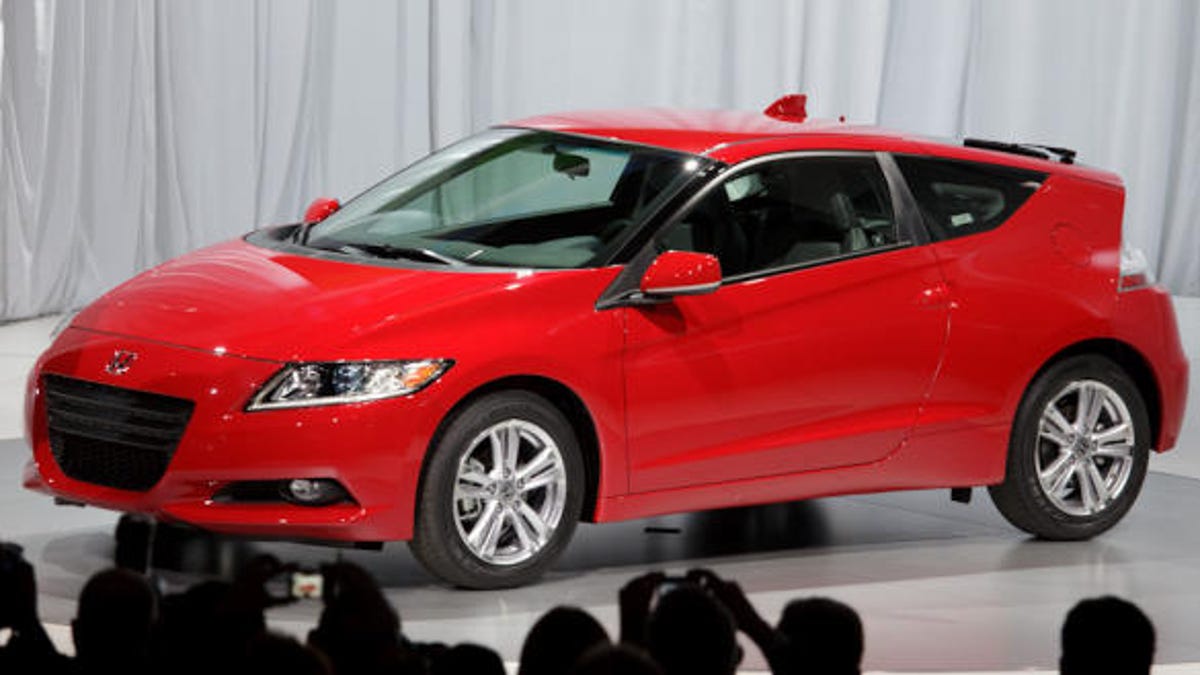After a rocky start, Honda's CR-Z joins U.S. hybrid derby
Automotive news reports on how Honda developed the hybrid CR-Z sports car.

TOKYO--Honda Motor's new CR-Z sporty hybrid is the car that nearly wasn't.
The wedge-shaped, two-seat hatchback was almost killed twice because engineers weren't convinced it was a unique concept and because U.S. bosses originally didn't want it.
When Norio Tomobe was appointed chief engineer of the project in the summer of 2004, the car was still a blank sheet. And in the early years, the working model had a traditional gasoline engine.
"We had serious doubts about whether this would bring new value," Tomobe said during a recent interview at Honda's headquarters here. "I really struggled for a new idea, and we decided to start over from scratch. The hybrid finally gave us the wow factor."
Yet going hybrid brought its own problems. Today critics assail the CR-Z as neither especially fuel-efficient nor sporty. And Tomobe is quick to admit at least one thing he wishes the CR-Z had: "more horsepower."
He said he would like a Type R sporty version of the CR-Z someday with a spunkier power-to-weight ratio that lives up to its sporty styling.
Compromise solution
But in the meantime, the CR-Z is an exercise in compromise. It was conceived as a 1.3-liter car for Europe but was given a 1.5-liter engine to appeal to U.S. drivers. It aims to be sporty with a six-speed stick-shift option but also comes in a version with continuously variable transmission to squeeze out extra fuel economy.
The result: a 122-hp package that delivers a 0-to-62-mph time that, at 9.7 seconds, barely edges the Toyota Prius. And fuel economy is only 36/38 mpg, well below the Prius' 51/48.
The 0-62 time comes from a leaked early edition of the Japanese sales catalog. Honda has dropped all references to it. Indeed, Honda conspicuously omits a 0-60 speed for a car that it touts as sporty.
The CR-Z went on sale in Japan in February and reaches U.S. showrooms this summer.
Honda plans to sell 40,000 to 50,000 CR-Zs a year worldwide, with 15,000 in North America. Japan sales are projected at 12,000 a year, and Europe will get the rest.
Tetsuo Iwamura, president of American Honda Motor, was skeptical right up until he drove the final prototype.
"He kept saying they don't need a hybrid," recalled Tomobe.
"In the American market, people equate hybrids with the Prius," he said of Iwamura's cool response. "If the hybrid is sporty, it's going to confuse the customers and dealers."
The CR-Z's fate was put before Takanobu Ito, now president of Honda Motor but then head of research and development. "He said, 'Don't worry about the States, just keep developing it,' " Tomobe said.
While driving early prototypes, Iwamura relentlessly derided the car, Tomobe said. But when he got behind the wheel of the final version, his reaction changed.
Suddenly, the project was a go.
"It's ironic that the United States was the most vocal in saying they didn't want the car, but the CR-Z still made its world debut at the Detroit motor show," Tomobe said.
Tomobe, who cut his teeth as chief engineer on Japanese market projects such as the Mobilio Spike and Elysion minivans, is unapologetic about the CR-Z's compromises.
"I'm satisfied," he said. "This is what the future of sports cars will be for Honda. We are not pursuing absolute maximum speed. What we aim for is a car that is exhilarating to drive."
On paper, the CR-Z's power may seem lackluster. But sporty handling makes up for it, Tomobe said. The three-mode drive system helps by delivering extra throttle responsiveness.
Drivers can select normal, economy or sporty driving modes. In sporty mode, drivers of the CVT can simulate stepped shifting manually by flipping paddle shifters on the steering wheel.
The CR-Z borrows liberally from its hybrid forerunner, the Insight, which came out last year. It has the same engine room, front flooring, fuel tank, and hybrid system. The motor, battery and inverter essentially are the same as the Insight's, Tomobe said.
Room for improvement
Not only is its engine larger than the Insight's 1.3-liter, but the CR-Z's engine has 16 valves instead of the Insight's 8. This is to help increase power at higher rpm and improve efficiency at lower speeds.
Up to 2,300 rpm, one intake valve per cylinder is closed to limit fuel consumption. Above that, all four valves are working to optimize power.
The CR-Z is also the first Honda hybrid to get a six-speed manual transmission.
Honda already is eyeing improvements. By boosting the storage capacity of the battery and making the motor and inverter smaller and lighter, future generations of the CR-Z should deliver better performance.
Said Tomobe: "There is room for further evolution."
Critics say Honda could score by offering a gasoline-only CR-Z. But Tomobe said the company has ruled that out. The car's identity is too closely linked to being a hybrid, he said.
But a Type R racing incarnation is another story. "If that appeals to people and contributes to Honda's sporty image, we need to consider all options," Tomobe said, adding that he would like to see an R.
That would require reworking the power-to-weight ratio and boosting the maximum speed. Tomobe said that is still a tall order for the current CR-Z and its eco-friendly mission.
Said Tomobe: "The CR-Z is supposed to be an intelligent sports car."
(Source: Automotive News)